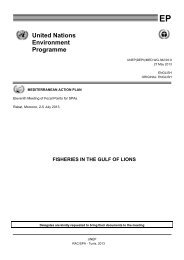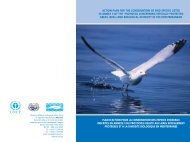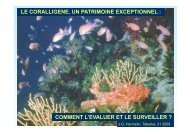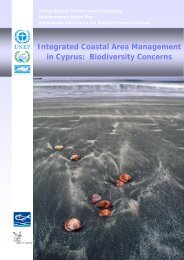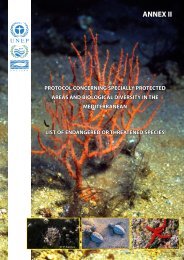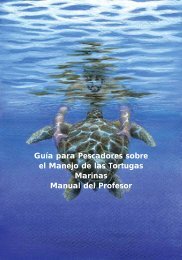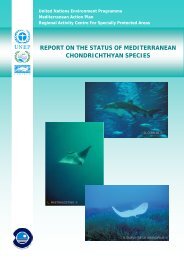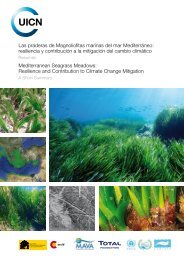Proceedings of the Second Mediterranean Symposium on Marine
Proceedings of the Second Mediterranean Symposium on Marine
Proceedings of the Second Mediterranean Symposium on Marine
You also want an ePaper? Increase the reach of your titles
YUMPU automatically turns print PDFs into web optimized ePapers that Google loves.
PROCEEDINGS OF THE SECOND MEDITERRANEAN SYMPOSIUM ON MARINE VEGETATION (ATHENS, 12-13 DECEMBER 2003)<br />
112<br />
lamourouxii) GDOR (sub Bryopsis balbisiana)<br />
Penicillus capitatus Lamarck At B<br />
Pseudochlorodesmis furcellata (Zanardini) Børgesen v. furcellata Abt !<br />
Rhizocl<strong>on</strong>ium tortuosum (Dillwyn) Kützing SC GDOR<br />
Ulva intestinalis Linnaeus C ! HbM R<br />
Ulva laetevirens Areschoug C ! HbM GE (sub U. lactuca) T3 (sub U. lactuca)<br />
Ulva linza Linnaeus C !<br />
Val<strong>on</strong>ia macrophysa Kützing P C<br />
Val<strong>on</strong>ia utricolaris (Roth) C. Agardh P ! HbM T<br />
Fucus vesiculosus Linnaeus and F. spiralis Linnaeus, found in 1996 in Liguria (Albisola<br />
M., SV), are not included: <str<strong>on</strong>g>the</str<strong>on</strong>g>y were probably discarded by human activity (recreati<strong>on</strong>al<br />
fishing). It’s worth stressing that exactly in <str<strong>on</strong>g>the</str<strong>on</strong>g> same locality, F. vesiculosus was found,<br />
apparently settled, by Picc<strong>on</strong>e at <str<strong>on</strong>g>the</str<strong>on</strong>g> end <str<strong>on</strong>g>of</str<strong>on</strong>g> 19th century (1889; 1891).<br />
The chorological spectrum <str<strong>on</strong>g>of</str<strong>on</strong>g> <str<strong>on</strong>g>the</str<strong>on</strong>g> actual list <str<strong>on</strong>g>of</str<strong>on</strong>g> Ligurian macrophytobenthos is showed in<br />
Fig. 2A. The cosmopolitan and sub-cosmopolitan elements dominate (C+SC=30,3%),<br />
with entities characterized by wide distributi<strong>on</strong> (A+AP+IA+IP=23,0%). Elements with<br />
warm affinities are more important (P+Abt+APt+At+IAt=19,3%) than <str<strong>on</strong>g>the</str<strong>on</strong>g> <strong>on</strong>es with cold<br />
affinities (Ab+APtf+IAtf+CB+CBA=16,0%). The <str<strong>on</strong>g>Mediterranean</str<strong>on</strong>g> comp<strong>on</strong>ent (M)<br />
accounts for <str<strong>on</strong>g>the</str<strong>on</strong>g> 11,2%.<br />
Fig. 2: A) Actual Chorological spectrum. B) Historical Chorological spectrum.<br />
Data in literature before 1950 enumerate 351 taxa. Of <str<strong>on</strong>g>the</str<strong>on</strong>g>se 208 have not been<br />
recorded in <str<strong>on</strong>g>the</str<strong>on</strong>g> last 53 years, but 77 <str<strong>on</strong>g>of</str<strong>on</strong>g> <str<strong>on</strong>g>the</str<strong>on</strong>g>m are dubious. The chorological spectrum,<br />
excluding dubious taxa, is showed in Figure 2B: elements with very large distributi<strong>on</strong><br />
dominate (28,3% and 22,4%); elements with warm affinities are lower than <str<strong>on</strong>g>the</str<strong>on</strong>g> <strong>on</strong>es<br />
with cold affinities (respectively 14,2% and 21,7%). The <str<strong>on</strong>g>Mediterranean</str<strong>on</strong>g> comp<strong>on</strong>ent is<br />
13,4%. In Tab. 1 <str<strong>on</strong>g>the</str<strong>on</strong>g> trend <str<strong>on</strong>g>of</str<strong>on</strong>g> each divisio is showed.




